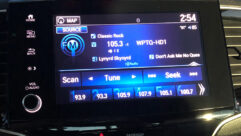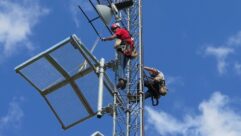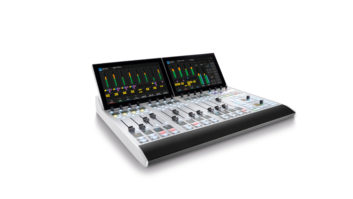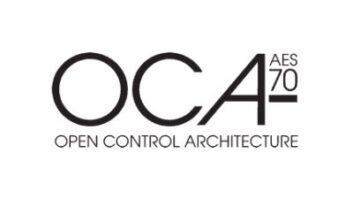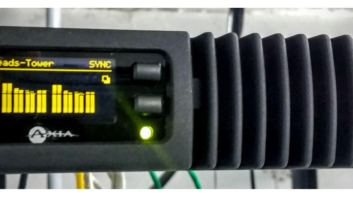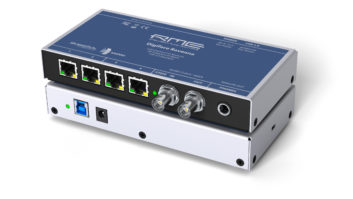(click thumbnail)While the unit’s features are numerous and control could be complicated, Tieline has included a starting set of configuration profiles that serve nicely for most of the manual tasks.I was intrigued when a pair of Tieline Commander G3 field codecs arrived at my office.
I had heard that audio over IP was The Next Big Thing but hadn’t touched any actual field devices; and I imagined that sending audio over the public Internet was just begging for trouble. I was just sure that any broadcast-quality connection would die miserably when enough people consumed all the bandwidth by surfing and downloading YouTube videos exactly at the moment of the broadcast.
It was with this expectation that I plugged one Tieline Commander G3 into an outside-the-firewall spigot at work, pressed the WIZ button to guide me through a static IP setup and plugged a stereo audio source into the rear XLRs. I carried the other Tieline home in my briefcase.
Once at home, I bid the family a cheery hello, plugged the Tieline into a Verizon FiOS [high-speed Internet] spigot, and “dialed” the Tieline at work.
Almost immediately, the connection framed at 128 kilobits MP2 stereo. “Naw,” I thought, “It can’t be this easy.” So I disconnected and ratcheted up the bit rate to 384 kilobits. The two Tielines connected and framed again, quickly and easily.
I thought this must really be The Next Big Thing.
Quality controls
The Tieline Commander G3 series of codecs, of which the TLF300 field codec is a member, share sophisticated and complex features.
They include two side-panel pluggable module slots for any combination of X.21/ISDN/POTS/GSM Wireless modules, with an integral 11 x 6 audio router to switch audio from simultaneous connected sources to destinations; extensive remote control and softkey/GPI programming capability; a number of popular, robust coding algorithms from MP2 to a raw linear stream; and, of most interest here, integral audio over IP.
The whole package is in a small enclosure measuring 8.56 x 8.58 x 2.95 inches — and it doesn’t even need a cooling fan. The external 12VDC power supply plugs into a four-pin XLR on the rear panel.
The TLF300 controls on the sloping front are straightforward and easy to understand. Each mixer section of the two-channel mixer has an on/off key, rotary level control and a headphone level and send/return audio balance control.
The codec’s “Intelligent Gain Control” can be enabled to operate like a limiter to manage levels exceeding +14 dBu. The input channel’s on/off button flashes when IGC is actually working. The IGC stage is after the 24 bit A/D processing, and is managed by the onboard 32 bit digital signal processor.
An additional, monaural auxiliary line input and output is exposed on RCA connectors on the left side. The auxiliary input level is controllable remotely or through the Tieline’s audio setup menu. Also on the left side panel are the two stereo headphone jacks, and Phoenix connectors for the two CMOS solid-state relay inputs and outputs. Each relay’s action is configurable by the included Tieline Toolbox software.
Adjacent to the front-panel mixer section is a telephone keypad, with dedicated keys for Hangup, Clear, Enter-Dial, Memory, Store and Soft Keys F1 and F2. An amply-sized backlit LCD screen above four soft keys displays menus and status and virtual level metering. My favorite control is a comfortably large “soft” menu selector knob with a press-to-accept button action.
On the rear are the two analog outputs and two line/mic inputs, individually configurable from the audio menu, or by the Tieline Toolbox software. Phantom power also can be enabled on both input XLR connectors.
While the Tieline 300TLF’s features are numerous and control could be complicated, Tieline has included a starting set of configuration profiles that serve nicely for most of the manual tasks.
In those cases where the user wants to make the 300TLF even easier — “automatic,” if you will — up to 98 configuration profiles can be created, edited and saved, such that a user need only apply power and be guided to the desired configuration by prompts from the display.
The 300TLF will, with the press of a soft key, recall a complete snapshot that includes phone numbers, input settings, audio routing, ISDN setup, function buttons, talkback operation and other necessary settings. All of this is easily programmed using the Tieline Toolbox software, and the snapshots can be saved to your local computer for safekeeping.
There are more than 20 factory audio matrix routing configurations provided, and they provide the usual routing between mic, headphone, encoder and decoder, as well as the arcane routings such as those that route the phone module audio to other destinations for use as a talkback or cue.
There are too many factor routing configurations to discuss here; each Tieline can hold up to 160 routing configurations. For an additional fee, Tieline can enable the Matrix Editor for users to create and save their own unique routing configurations.
Product Capsule
Tieline Commander 300TLF Field Codec
Thumbs Up

- Small, compact
- Extremely flexible
- Multiple, simultaneous connections
- Internal audio routing matrix
- Easy to use
- Pretty, “photo-virtual” remote control software included
- Comprehensive configuration software, the Tieline Toolbox, included
- Firmware upgrades easily made
- Well-written manual
- Two can remotely control each other, including audio gain.
Thumbs Down
- Some features programmed only by Toolbox software
- Some features available at additional charge
- For configuring complicated tasks, its complexity requires thoughtful setup
Price
Commander field unit with wired IP and POTS: $3,025
Contact
Tieline | (317) 845-8000 | visit www.tieline.comTake two
We had occasion to use the 300TLF on two remote broadcasts.
The first was for transmitting a music concert in New York City back to NPR, where the audio was passed to the NPR Digital Media Division for Web streaming.
The concert venue had exactly two POTS lines into the building (voice and fax, nowhere near the sound board) and no possibility for ISDN installation. It did, however, have high speed “public” Internet access.
Ignoring the POTS lines, we decided to ship up a 300TLF a few days before the gig and check the quality of Internet service. The producer decided that if the Tieline couldn’t make and hold a connection — the only hope for getting live audio out of the venue — the gig would not be streamed live.
I pre-configured the 300TLF, quickly setting up the IP connection for DHCP from the front panel, guessing that regardless of the Internet service provider, the connection would flow through the ISP’s router that would assign the Tieline an IP address and handle the data routing to the outside world.
I selected a modest bit rate with a robust algorithm — 128 kilobits MP2, J-Stereo as the coding algorithm — realizing the resulting audio would be further bit-rate reduced for Web streaming. I selected the factory profile “ManDflt Stereo,” which instantly configured the Tieline’s inputs and outputs for stereo. The two front-panel inputs become left and right IN, with stereo audio feeding the headphones and the stereo balanced outputs, as well as to the IP destination.
Because the remote site was assigned an arbitrary IP address through DHCP, the remote site had to “call” our rack-mounted Tieline TLR300B2, which uses a static IP address. All it had to do was turn the menu selector to highlight “IP,” touch the keypad to enter NPR’s Tieline IP address and press the menu selector to “dial” the IP.
The test went well, and on the night of the concert, the Tieline connected and stayed connected throughout. The producer was thrilled.
The second broadcast test was for the afternoon talk program’s live remote from Fairbanks, Alaska. Again, ISDN was simply not available, but Switched-56 service was, and we had to scrounge for the ancient equipment to use for the live broadcast remote.
It was almost as an afterthought that we included a 300TLF in the site survey kit, in the event that sufficient Internet bandwidth was available. We were pleasantly surprised that the Tieline had no problem holding a connection during the site survey, and included it in the remote equipment pool.
On the broadcast day, we were able to get one of the two Switched-56 lines to frame after much fussing, but the 300TLF connected easily to our rack-mounted 300TLB at 128 kilobits, MP2, J-Stereo. A numerical “signal strength” value on the display showed numbers ranging from 79 to 95, where 99 is the highest “strength.” The lower the number, the more likely a connection will experience dropouts or audible artifacts.
We compared the incoming audio arrival times of the Switched-56 and the Tieline (in quality, the Tieline was far superior), and noticed at first the Tieline lead the Switched-56 by some milliseconds, and over time the Tieline lagged behind the Switched-56.
This brought home the realization that the public Internet is not a guaranteed bit stream like a 64 kilobit ISDN channel; some IP packets will take longer to arrive than others, and there is a penalty if you try to run your intense laptop Web applications on the same Internet connection the Tieline uses.
We heard this during the broadcast as the Tieline had moments of slightly “watery” artifacts, and in an informal conversation with the technical director after the broadcast, she mentioned several remote production staff were remotely logged into NPR on the same hub, so they could write scripts and manage the call screener.
The latency, however, was low enough to still be “interactive,” as the phone calls were mixed into the program in Washington, but heard by the host in Alaska. When the remote Switched-56 codec’s output went dead during the broadcast, the Tieline was the only path to get backfeed audio to the site.
In using the Tieline 300TLF, it is apparent that we have barely exploited its features in our daily broadcast tasks; this review is but a bare outline of its many capabilities and operation. For those wishing to move audio from one remote place to another by any number of means, and the task at hand requires easy of use or simultaneous connections to a single codec, the Tieline Commander 300TLF is a fine investment.
